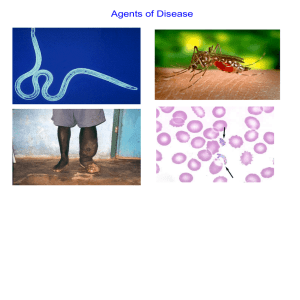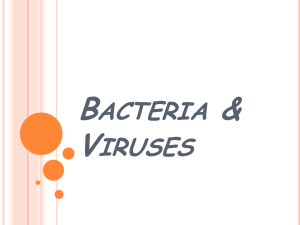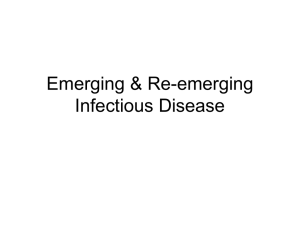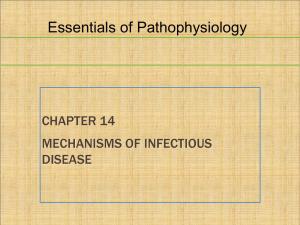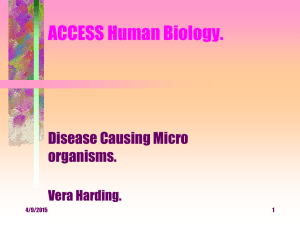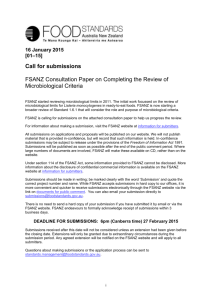Powerpoint
advertisement
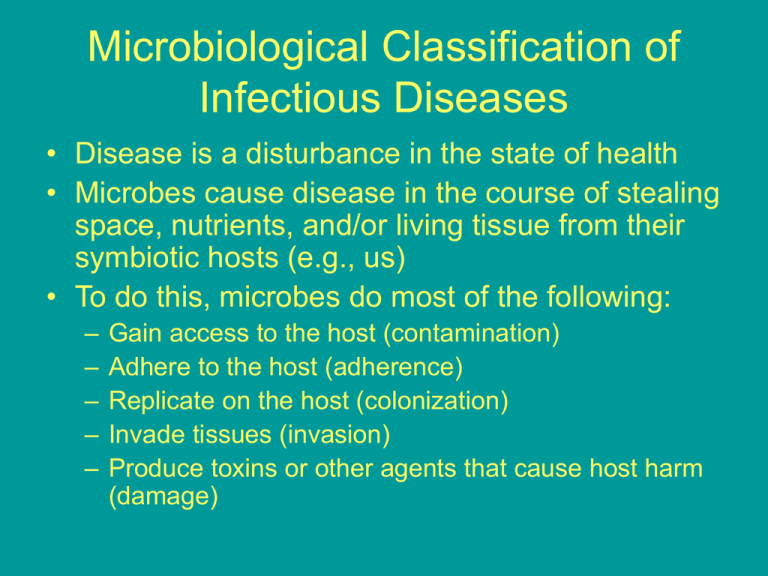
Microbiological Classification of Infectious Diseases • Disease is a disturbance in the state of health • Microbes cause disease in the course of stealing space, nutrients, and/or living tissue from their symbiotic hosts (e.g., us) • To do this, microbes do most of the following: – – – – – Gain access to the host (contamination) Adhere to the host (adherence) Replicate on the host (colonization) Invade tissues (invasion) Produce toxins or other agents that cause host harm (damage) BIOLOGIC CHARACTERISTICS OF INFECTIOUS AGENTS • Infectivity – the ability to infect a host • Pathogenicity – the ability to cause disease in the host • Virulence – the ability to cause severe disease in the host • Immmunogenicity –the ability to induce an immune response in the host Infectious Disease Terms Infectious dose – number of organisms needed to successfully infect Latent period - exposure to infectiousness interval Incubation period – interval from exposure to clinical symptoms Infectious period – interval during which host can transmit infection Reproductive rate – ability of an agent to spread in populations Virulence Pathogenicity Immunogenicity Outbreak – limited spread Endemic – usually present; steady prevalence Epidemic – rapid spread Pandemic – occurring across countries and in multiple populations Important Terms MODES OF TRANSMISSION • Direct – Droplet – Aerosol – Skin to skin • Indirect – Fomites (clothes, blankets, door handles etc) – Vectors (e.g. mosquitoes) – Food and water – Intermediate hosts (e.g. snails) CLINICAL RESPONSES TO INFECTION BY AN AGENT • Inapparent infection – no clinical symptoms generated • Carrier state – usually no clinical symptoms but host can transmit infection for long periods • Clinical symptoms – – – – Mild disease Severe disease Residual impairment death CLASSIFICATION OF INFECTIOUS AGENTS (1 of 2) • Bacteria – survive on appropriate media, stain gram-positive or -negative • Viruses – obbligate intracellular parasites which only replicate intracellularly (DNA, RNA) • Fungi – non-motile filamentous, branching strands of connected cells • Metazoa – multicellular animals (e.g.parasites) with complicated life cycles often involving several hosts CLASSIFICATION OF INFECTIOUS AGENTS (2 of 2) • Protozoa – single cell organisms with a welldefined nucleus • Rickettsia – very small bacteria spread by ticks • Prions – unique proteins lacking genetic molecules • Chlamydia – bacteria lacking cell walls Size Comparison of Microbes Bacterial Cell Structure James D. Dick, PhD, Johns Hopkins University Taxonomy of Bacteria Strain O157:H7 Microbiological Classification of Infectious Diseases • Bacteria are classified by their Gram stain characteristics. • Gram staining is the application of a crystal violet dye to a culture of bacteria. Bacteria that retain the color of the dye are called Gram positive; bacteria that don't are Gram negative. – The Gram stain attaches to peptidoglycan in the bacterial cell wall. • In Gram-negative bacteria, the peptidoglycan layer is protected by an outer membrane. Microbiological Classification of Infectious Diseases Microbiological Classification of Infectious Diseases Microbiological Classification of Infectious Diseases • Viruses are acellular, obligate intracellular organisms. • The complete infectious virus is termed a virion. • The virion consists of the specific nucleic acid (DNA or RNA) surrounded by a protein coat (capsid). – Some viruses are enveloped which means that they possess a lipoprotein coat that surrounds the capsid and is acquired from infected host cell membrane. – Viruses that lack an envelope are “naked.” Microbiological Classification of Infectious Diseases • Viruses are typically classified by: – Genetic material (DNA vs. RNA) – Strandedness (single vs. double) – Size and shape of the capsid and whether its enveloped or non-enveloped – Method of replication Microbiological Classification of Infectious Diseases Microbiological Classification of Infectious Diseases Microbiological Classification of Infectious Diseases Viruses Entry into the Host Cell with an Envelope Viruses Entry into the Host Cell with an Envelope Microbiological Classification of Infectious Diseases • All fungi are chemoheterotrophs • Pathogenic fungi have two forms: yeasts (unicellular) and molds (multicellular) • Some fungi are dimorphic (this is particularly true for the pathogenic fungi) • Molds grow as filamentous, branching strands of connected cells known as hyphae Microbiological Classification of Infectious Diseases • Types of Parasites: – Protozoa: Single-celled, microscopic organisms that can perform all necessary functions of metabolism and reproduction. Some protozoa are free-living, while others parasitize other organisms for their nutrients and life cycle. • The morphology of protozoa varies widely and includes oval, spherical and elongated cells that can range in size from 510 to 1-2 mm. • Structurally, the protozoa resemble other eukaryotic cells and possess a cytoplasmic membrane that encloses cytoplasm containing membrane-bound nuclei, mitochondria, 80s ribosomes and a variety of organelles. Microbiological Classification of Infectious Diseases • Types of Parasites: – Helminths: A large, multicellular organism (worm) that is generally visible to the naked eye in its adult stages. – Helminths can be free-living or parasitic. • Nematodes: Roundworms • Trematodes: Flukes • Cestodes: Tapeworms Microbiological Classification of Infectious Diseases • Prions are abnormal, transmissible agents that are able to induce abnormal folding of normal cellular prion proteins in the brain, leading to brain damage and the characteristics signs and symptoms of the disease. • Prion diseases are usually rapidly progressive and always fatal.

